LAB REPORT
Science and Technology Making Headlines
March 16, 2018

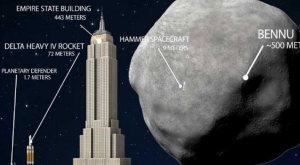
Deflecting the massive asteroid 101955 Bennu was the focus of recent research by a national planetary defense team. Bennu will make a very close approach to Earth on Sept. 25, 2135.
Asteroids get hammered
Scientists have designed a nuclear weapon–wielding spacecraft powerful enough to deflect a 1,600-foot asteroid currently circling the sun.
Set for multiple close encounters with Earth over the next hundred years, there is a chance -- however vanishingly small -- that the asteroid Bennu could one day collide with our planet.
Don’t worry. NASA and Lawrence Livermore have a plan to save the planet. Called the Hypervelocity Asteroid Mitigation Mission for Emergency Response, or HAMMER, the "impactor" spacecraft would be deployed to deflect a small asteroid with its own bulk. In certain cases, however, it would set off a nuclear weapon.
“If the asteroid is small enough, and we detect it early enough, we can do it with the impactor,” said LLNL physicist David Dearborn. “The impactor is not as flexible as the nuclear option when we really want to change the speed of the body in a hurry.”

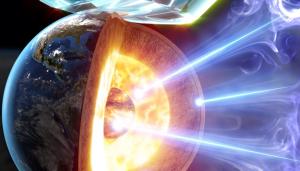
LLNL scientists discovered that at the thermodynamic conditions in Earth’s core, metals such as iron and nickel become electronegative and attract electrons. Image by Adam Connell/TID
Missing gas to the core
Earth's xenon is missing. But a new experiment suggests it might have been right under our feet all along.
Earth's atmosphere contains less xenon than it should, at least based on studies of some of the oldest space rocks in the solar system. Carbonaceous chondrites contain the most primitive materials known in this planetary system. They're made of the same stuff that eventually coagulated to make Earth. That's where the mystery comes in: Carbonaceous chondrites contain way more xenon than Earth and its atmosphere.
Xenon is a noble gas. And noble gases don't react very well with other elements, so Earth's missing xenon shouldn't have been used up in chemical reactions over the eons, according to Lawrence Livermore physicist Elissaios Stavrou.
Trying to figure out where it went, Stavrou and his colleagues tested the hypothesis that the missing gas could be camped out in Earth's core.

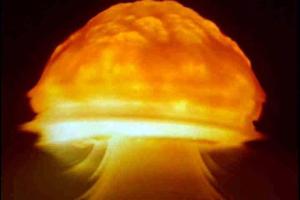
Operation Dominic was a series of 31 nuclear test explosions with a 38.1 megaton total yield conducted in 1962 by the United States in the Pacific. Operation Dominic is one of the more than 300 nuclear test films that have been declassified.
Boom or dust
Lawrence Livermore released 200 declassified videos of Cold War nuclear test explosions last week, relics of the 20th-century arms race between the U.S. and Soviet Union.
From 1945 to 1962 the U.S. performed 210 of these open-air nuclear explosions, starting with the Trinity test blast during World War II. They ended amid environmental concern over the spread of radioactive fallout worldwide from U.S. and Soviet tests.
“Once the [bomb] yield was announced, they were supposed to be declassified," Lawrence Livermore National Laboratory nuclear weapons physicist Greg Spriggs said. “But they were just rotting away on shelves” and turning to dust.
More than 5,500 high-speed films of the test blasts were made by nuclear weapons lab scientists to estimate the blast “yields” (the size of the explosion) during the Cold War. The 200 newly released films join two earlier releases, bringing the total number of declassified videos to 309 available on an LLNL YouTube channel.

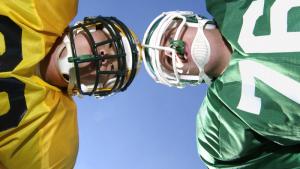
New LLNL research shows repetitive hits to the head, like those endured in football, are tied directly to chronic traumatic encephalopathy, a debilitating brain disease.
CTE hazards from hits to the head
Repetitive hits to the head can not only cause a concussion in some cases but more often can lead to the debilitating brain disease chronic traumatic encephalopathy (CTE), according to new research by Lawrence Livermore and Boston University.
The research highlights the risks of younger athletes playing contact sports and could lead to questions about the effectiveness of current concussion protocols.
The study used two methods to come up with its findings: A postmortem examination of four teenaged brains and a study of mice that showed instant changes to the brain after trauma -- even without telltale concussion symptoms.

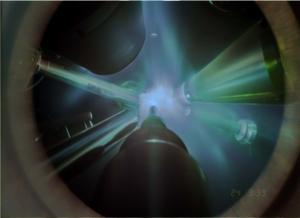
Time-integrated image of a laser-driven shock compression experiment to recreate planetary interior conditions and study the properties of superionic water. Image by M. Millot/E. Kowaluk/J.Wickboldt/LLNL/LLE/NI
Weird water
Experts at Lawrence Livermore National Laboratory have used powerful lasers to super-heat pressurized ice called ice seven. Laser pulses then heated this material which resulted in even greater pressures to create the new material which was first theorized 30 years ago.
Superionic water is both solid and liquid and is created under pressure a million times greater than that on Earth.
Researchers believe superionic water exists deep within planets like Uranus and studying it could lead to the development of new exotic materials in the future.





